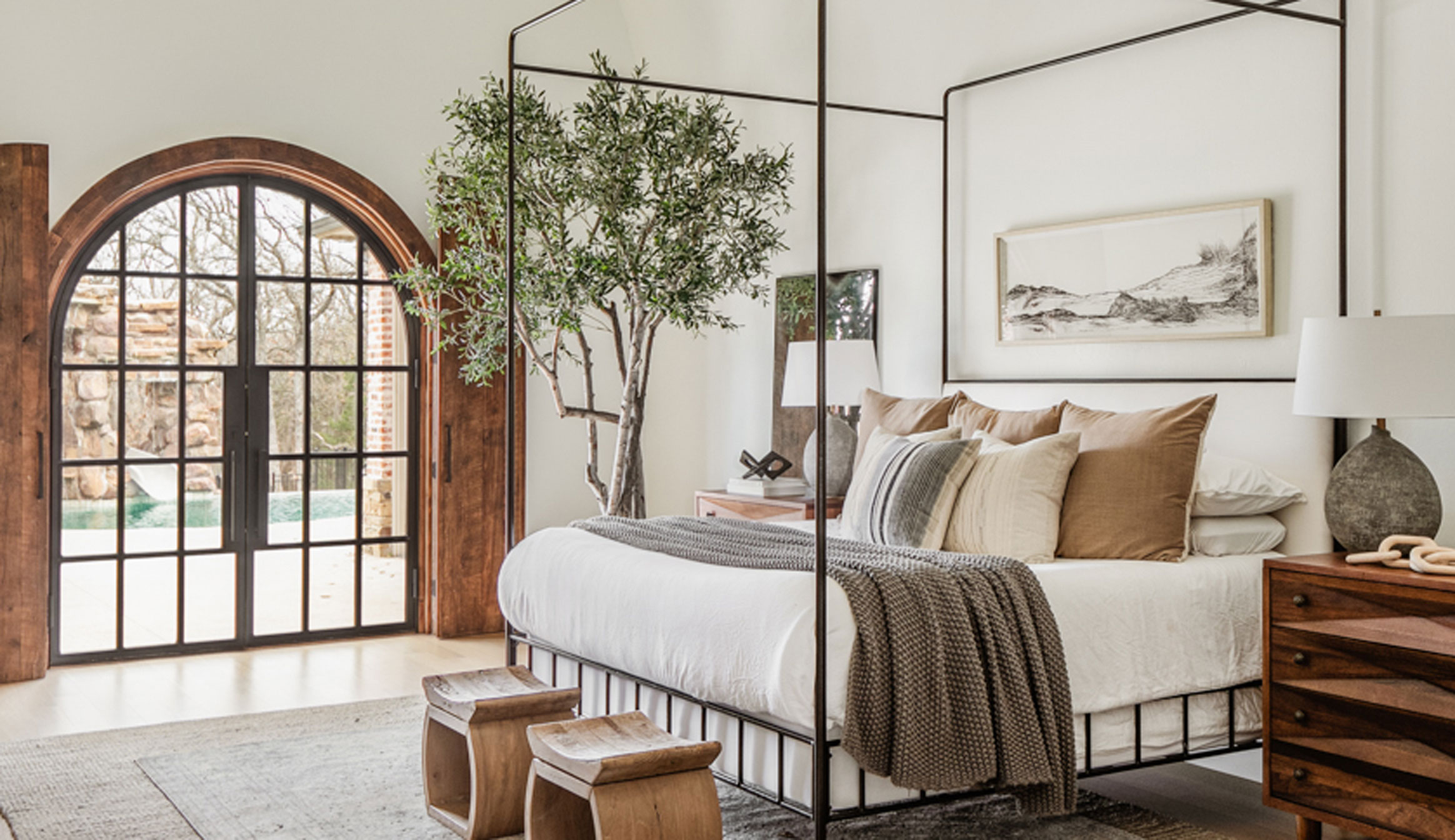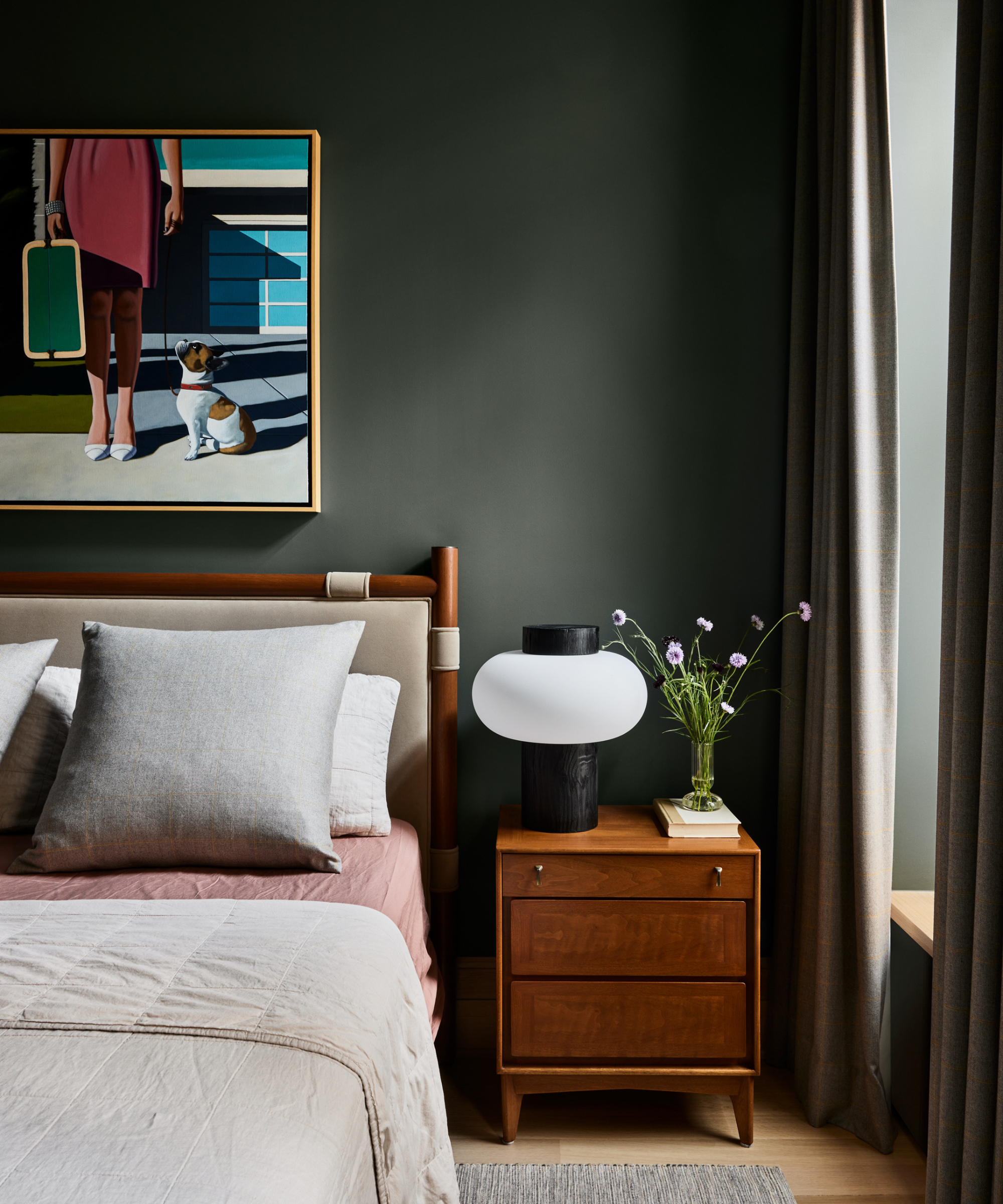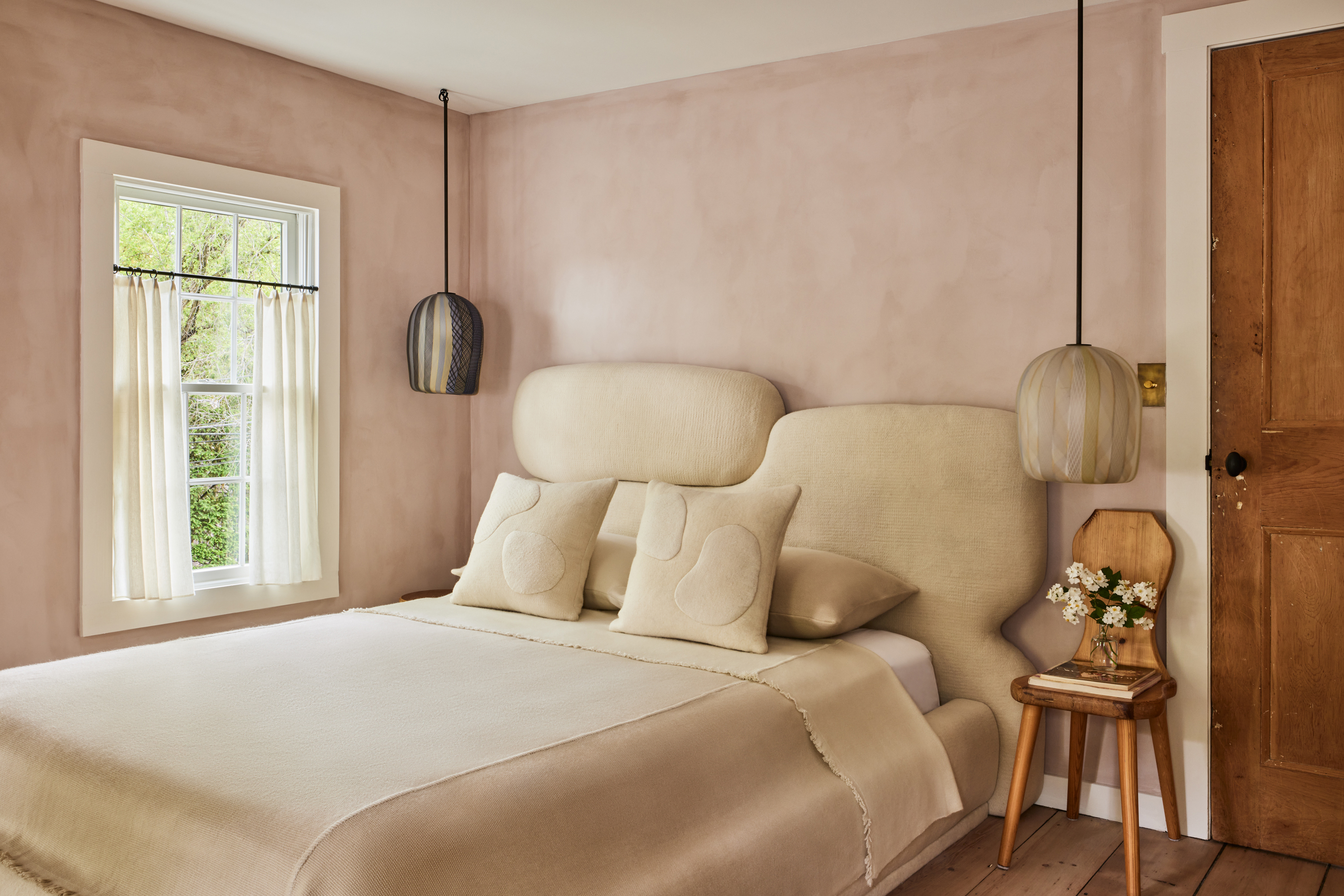
Most Invested is a monthly series in which one of our style editors or a friend of Livingetc explains the do’s and don’ts of making the most important product decisions, and showcases the items they’d be adding to their cart.
Your bedroom is your haven; decorate it as such. Each piece of furniture should be functional but also stylish; exciting but also calming; chic but also timeless. It's a tall order, considering you probably hope to invest in a suite of furniture only once.
At the core of this essential vignette is the bed frame, the centerpiece around which the rest of your bedroom revolves. Your bed is typically one of if not the largest pieces of furniture in your house and you use it every day — to get the most out of it, you should be considered and careful when buying. So how do you decide the best bed frame for you?
We asked the experts.
What to know before buying a bed frame
How much should a bed frame cost: According to our panel of experts, a good starting point is around $300, "with the price increasing if you're looking for a high-end wooden frame" or upholstered option, advises Aino Heinäsuo, head of design at Redecor. As for the top end of that budget, $1500 should suffice, adds Anna Tatsioni, lead interior designer and architect at Decorilla Online Interior Design. "It will depend on the size and material you prefer," but "in my experience, investing in this range will make sure you get a good balance of quality and value."
Material: You need a material that works with your lifestyle, not against it. We'll dive into the specifics of three popular options below — wood, upholstery, and metal — but for a top-line read, experts cite metal bed frames as typically the most long-lasting, followed by well-made wooden frames. Upholstered frames can "wear out and lose their shape," Aino says, and/or "may require more upkeep to maintain their pristine look," Amanda adds. That said, you can, of course, extend the lifespan of an upholstered bed frame with proper care.
Height: The average bed height is usually about 24" to 25" off the ground, including the mattress, but that number can change depending on your height, the height of your ceilings, and the style of your bed frame. "Always, always, always consider the room as a whole.," Anna warns. "I can’t tell you how many times I have seen a beautiful frame look out of place because it wasn’t scaled correctly for the space. Make sure to measure the room, consider the ceiling height, and think about how the frame will interact with your other furniture pieces."
Think about it this way — your bed should be "easy to get in and out of, even when you're half-asleep," Amanda Foster, interior architect and founder of Foster Decor Consulting says. "Measure twice, buy once! Always double-check the dimensions of your space and mattress before purchasing a bed frame."
Construction: Again, everything depends on your taste and style, but you should generally stick to frames with "study construction, easy assembly, and a design that complements your bedroom's aesthetic," Amanda explains. Look for "well-built slat systems" or "robust box-spring support" (I'd recommend checking the reviews for commentary on this), which is "crucial for the longevity of the frame and the comfort of your mattress," Anna adds.
Trends: If you know what you like and what your room needs, you shouldn't feel beholden to bedroom trends when purchasing a bed frame. But here's a look at what's popular now, according to our panel of experts:
- Multifunctional Designs: "I have noticed multifunctional bed frames are gaining popularity, and built-in storage is huge!" Anna says. Aino agrees: "Functional bed frames with built-in features, such as small night tables, have been trending for some time and continue to be popular."
- Low Profile: Per Aino, "Low-to-the-ground frames are currently popular, contributing to a modern, minimalist aesthetic."
- Natural Finishes and Warm, Earthy Tones: "There's also a trend towards using light natural materials, such as light wood and upholstery, often drawing inspiration from Japandi aesthetics," Aino continues. This helps to bring a "touch of nature indoors," says Amanda.
- Bold, Abstract Headboards: "Statement headboard ideas in unique shapes and materials are all the rage," Amanda says.
Wood Bed Frames

"Wooden bed frames are the chameleons of the design world," Amanda tells us. "They fit seamlessly into rustic, farmhouse, Scandinavian, and even modern minimalist aesthetics. Think warm tones, natural textures, and a touch of vintage charm."
"I always tell clients to consider wooden frames if they are looking for a piece that will last and adapt to changing styles over time," Anna adds.
- PROS: Long-lasting, versatile, and often eco-friendly; timeless appeal; adds warmth and texture
- CONS: Heavy and often difficult to move; higher price tag; might require "regular polishing and care to prevent scatches and dents," per Amanda
The Bottom Line: "If you're looking for a bed frame that ages like fine wine and adds a cozy, natural vibe to your bedroom, wood is your best bet," Amanda explains. "Plus, it's perfect for those who love a touch of nature in their decor."
Price: $370, Was: $440
Size: 58.39'' W X 83.96'' L x 43.5" H
The Grady looks to offer the quintessential wooden bed frame style and versatility while still delivering on price — especially when it's on sale. The extending posts on the headboard and the round tapering legs are distinctly mid-century modern, while a "slat roll foundation" eliminates the need for a box spring. Moreover, the piece boasts a "Wayfair Verified" seal of approval, which means it has been inspected by a Wayfair Product Expert and is loved by customers. (Note: AllModern is a Wayfair brand.)
Price: $399
Size: 12"H x 63"W x 83"D
For a higher-quality wooden bed frame at a fair price, try Article's Basi, shown above in the Walnut stain (a white and oak stain are also available). This Canadian brand does mid-century exceptionally well, so they're undoubtedly one to trust (and if you need more convincing, check the 4.6-star customer rating). There isn't a headboard, but think of buying one separately as an opportunity to experiment with a bold color or mismatched material.
Price: $1098
Size: 54"H, 63.75"W, 85"D
Speaking of customer favorites, the Quincy is positively beloved, with 4.8 stars across 17 ratings (for context, 17 is a lot for Anthropologie, an editor favorite). Its Cedar construction boasts a wooden slat support system, while its surface is sealed in a clear lacquer for protection from dings and scratches. For a full suite of wooden bedroom furniture, add in the Quincy charging nightstand, the Quincy five-drawer dresser, and the Quincy desk.
Price: $699
Size: 80" L x 58" W x 44" H
The slatted design of the Juliette adds the perfect bit of texture and dimension without overwhelming — you don't even need the headboard (although if you want it, Urban does sell it separately). Extremely mid-century modern and design-forward.
Upholstered Bed Frames

"Whenever I want to create a cozy and luxurious feel, my go-to is upholstered bed frames," Anna says. "They work in contemporary, glam, and transitional design schemes." Think "plush fabrics, vibrant colors, and a headboard that makes you feel like royalty," Amanda adds.
The main advantage of an upholstered bed frame is "comfort, as soft headboards making sitting up in bed more comfortable," Aino explains. "However, they can be more challenging to clear, especially with light-colored fabrics." The material might wear out over time, or trap "dust and allergens" that bring on an undesirable bout of the sniffles.
- PROS: Luxurious; comfortable (great for reading); add an element of sophistication; lots of variety to choose from (plenty of "fabrics, colors, and textures," Amanda says); touch of texture
- CONS: Requires regular cleaning; less durable; potential to trap dust and allergens; not great for homes with pets that love to scratch
The Bottom Line: Upholstered bed frames are "definitely" the right choice for "those who want to prioritize comfort and who want to make a style statement," Anna says.
Price: $1649, Was: $2189
Size: 49'' H X 69'' W X 92'' L
The Sereno is not for the faint of heart ... but if you're up for it, this tattersall-covered frame, available in six other funky fabrics should you prefer, will make a showstopping statement. The low-profile design is very popular right now, and the cotton headboard adds comfort when reading or lounging. No box spring required.
Price: $2798
Size: 69" H x 68" W x 88" D
For a sleep fit for a queen, the regal-looking Ainsworth should suffice. Shown here in the made-to-order velvet "Moonstone" fabric, this plush upholstered beauty has luxury written all over it. The maple legs are removable if you prefer a true low-profile experience, and you can choose from five different upholsteries and a myriad colors if the soft look of the Moonstone isn't your favorite. Be sure to measure twice, as Amanda suggests, before buying — this piece is subject to a 25% restocking fee if returned.
Price: $1399
Size: 41"H x 81"W x 88"D
Article stuns once again with this tan leather upholstered frame from the customer-loved Sven product line. The camel-colored material is a "full-aniline leather that's smooth to the touch," wrapping around the solid and composite wood frame and foam-padded tufted headboard. Wooden slats included and assembly is estimated to take around 1 hour. "The material, the design, the style makes this a fantastic bed," said one customer.
Price: $580
Size: 62" W x 49" H x 83" D
Target's Threshold line is excellent for high design on a budget, and the Olivia bed is a case in point. It costs half the price of its counterparts but looks every bit as chic. Great, too, for someone looking for something simple. Though it's available in a total of seven colorways, the Olive option is perhaps the most enticing and on-trend.
Metal Bed Frames

"Metal bed frames are best suited for industrial settings, where simple, functional designs with metal finishes fit seamlessly," Aino suggests. " Metal frames are durable and long-lasting, often more affordable than wood or upholstered options. However, they can be less comfortable to lean against."
Anna has had "great success" using metal frames in "minimalist and traditionalist settings," too, she tells us. " In one of my recent projects, I used a brass frame to add a touch of elegance to a modern bedroom."
- PROS: Affordable; long-lasting; resistant to wear and tear; lightweight; easy to move; easy to clean and maintain; mixes well with vintage decor; adds "airy and open feel," Anna says
- CONS: Sensitive to the temperature of the room; possibly squeaky if not assembled properly; can feel cold or out of place if not styled well; often uncomfortable to lean against
The Bottom Line: "If you're all about that sleek, modern look and need a bed frame that's both durable and easy to maintain, metal is your go-to," Amanda says. "Plus, it's perfect for those who love to switch up their decor frequently."
Price: $1298
Size: 59"H x 63"W x 83"D
The Deco is something straight out of a princess fantasy (though it's appropriate for every age). Inspired by Art Deco motifs, this curling iron frame (which also has a wooden slat support system) isn't necessarily minimalist, as our experts suggested, but it's certainly industrial and totally showstopping. Some customers have reported wear on the gold hardware upon delivery, but the majority rave about the look and handmade feel.
Price: $199
Size: 83" L x 63" W x 55" H
It's not as showstopping as the Deco, but this IKEA bed is beloved by customers, well-priced, and nonetheless quite charming. Would love to see this in a rustic farm or lakehouse, or even in a child's bedroom. Also available in white.
Price: $166.96
Size: 82.5"L x 62"W x 42.5"H
As a brand, the Novogratz expertly combines form, function, and affordability. With the Bushwick, you get a metal bed frame with a design that's a little bit different than other options on the market (the finials are the standouts here) and at a showstopping price point.
Price: $230.99
Size: 72" H x 60.32" W x 83" D
"In one of my recent projects, I used a brass frame to add a touch of elegance to a modern bedroom," Anna tells Livingetc. Lean into that look with this gold metal canopy bed from Zinus, an excellent frame brand with solid construction, good prices, and ever-excellent customer reviews. Make sure to measure here; because of their height, canopy beds are more difficult to fit.
FAQs
Is it worth buying a good bed frame?
We spend a third of our lives asleep in our beds, so it's not the place to skimp when it comes to comfort. Remember that a "good bed frame is an investment in sleeping better and overall well-being," notes Amanda Foster, interior architect and founder of Foster Decor Consulting.
Poor quality bed frames may feel less stable, especially for those prone to tossing and turning, and squeak, or make noises. However, your mattress will have a more direct impact on how you sleep in your bed, so if it's a good night's rest your after, this is where to invest first.







